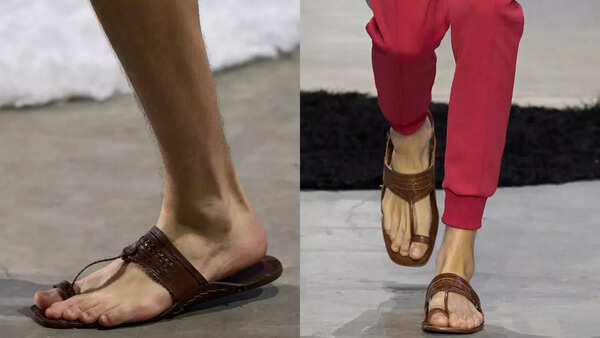Prada has finally recognized the influence of traditional Indian footwear on its new sandal design after facing criticism for cultural appropriation. The luxury fashion house's Spring-Summer 2026 men’s collection featured sandals that bore a striking resemblance to Kolhapuri chappals, a handcrafted leather footwear originating from Maharashtra, India.

Initially, the sandals were simply described as "leather sandals" in Prada's show notes, omitting any reference to their Indian origins. This sparked outrage among fashion observers and advocates for traditional crafts.
Lalit Gandhi, president of the Maharashtra Chamber of Commerce, Industry and Agriculture, publicly called out Prada. He emphasized the cultural significance and artisanal heritage of Kolhapuri chappals, which have held a Geographical Indication (GI) tag since 2019, protecting their unique origin and craftsmanship.
Responding to the criticism, Lorenzo Bertelli, head of Corporate Social Responsibility at the Prada Group, sent a letter to Gandhi acknowledging the design's inspiration. Bertelli admitted that the sandals were indeed influenced by traditional Indian handcrafted footwear, recognizing its "centuries-old heritage." He clarified that the collection was still in its early design phase, with no production or sales underway.
Bertelli further stated Prada's respect for Indian craftsmanship and expressed a desire to explore collaborations with local artisans in the future.
While Prada's acknowledgment is a welcome step, the incident underscores the critical need for cultural sensitivity and ethical practices within the fashion industry. Recognizing and crediting the origins of designs is essential, as is supporting the communities and artisans who preserve these traditions.
The controversy highlights the importance of moving beyond simply "borrowing" cultural elements. True cultural exchange involves acknowledging sources, collaborating with artisans, and supporting the continuation of traditional crafts. If this situation leads to greater awareness and support for artisans, it could signify positive change in the fashion industry.
Newer articles
Older articles
 Patience Urged for Australia's Rebuilt Top Order Amidst Test Transition
Patience Urged for Australia's Rebuilt Top Order Amidst Test Transition
 Kohli's Composure Under Pressure: Sharma Credits Mental Fortitude for Key Innings
Kohli's Composure Under Pressure: Sharma Credits Mental Fortitude for Key Innings
 West Indies Coach Daren Sammy Fined, Reprimanded for Umpire Criticism
West Indies Coach Daren Sammy Fined, Reprimanded for Umpire Criticism
 Bangladesh Coach Phil Simmons Leaves Sri Lanka Tour for Medical Check-up in London
Bangladesh Coach Phil Simmons Leaves Sri Lanka Tour for Medical Check-up in London
 Rishabh Pant: Greg Chappell Hails India Star as Cricket Revolutionary
Rishabh Pant: Greg Chappell Hails India Star as Cricket Revolutionary
 Pant's Fearless Hitting vs. England Draws Adam Gilchrist Comparisons From Greg Chappell
Pant's Fearless Hitting vs. England Draws Adam Gilchrist Comparisons From Greg Chappell
 IND vs ENG, 2nd Test: Rishabh Pant's Composed Reply Silences Harry Brook's Sledge About Fastest Century
IND vs ENG, 2nd Test: Rishabh Pant's Composed Reply Silences Harry Brook's Sledge About Fastest Century
 Neeraj Chopra Tips Jasprit Bumrah for Javelin Success, Cites Cricketer's Strength and Fitness
Neeraj Chopra Tips Jasprit Bumrah for Javelin Success, Cites Cricketer's Strength and Fitness
 Gambhir Backs India's Lower Order Despite Headingley Test Collapse, Cites Costly Dropped Catches
Gambhir Backs India's Lower Order Despite Headingley Test Collapse, Cites Costly Dropped Catches
 Carlsen on Gukesh's World Champion Status: 'Impressing Me Still a Question'
Carlsen on Gukesh's World Champion Status: 'Impressing Me Still a Question'